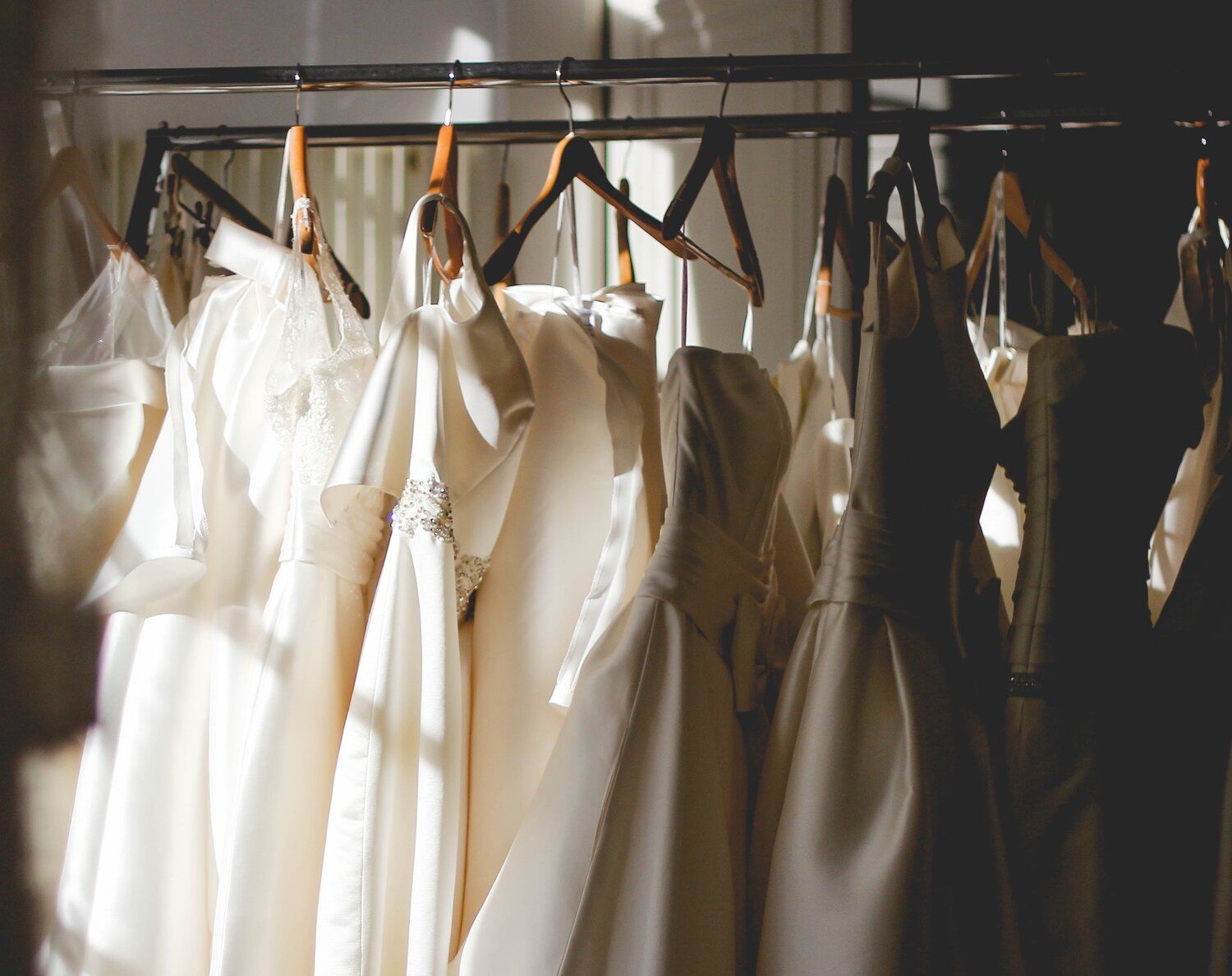Everything You Need to Know About Wedding Dress Preservation

By Kristi Kellogg
Today's brides have plenty of options for what to do with their wedding dresses after the big day. Some choose to donate or sell their gowns while others repurpose their dresses into lingerie or cocktail attire. And let's not forget those who "trash it" with a color bomb-filled photoshoot. Many brides, however, want to hang on to that dress that represents so much love, happiness, and celebration.
That's why wedding dress preservation is so important. A wedding dress is usually intricately designed and extremely delicate, and it can't be cleaned like any other dress. Wedding dress cleaning and preservation are key to making sure your dress lasts a lifetime. If you choose not to preserve your wedding dress, you may risk the following:
- Yellowing of the fabric
- Brown oxidation spots
- Mold and mildew growth
- Permanent fabric creasing
What Is Wedding Dress Preservation?
Wedding dress preservation involves a series of special cleaning and packaging techniques to ensure the garment will retain its quality.
Wedding Dress Preservation Cost
It's important to factor wedding dress preservation into your wedding budget. Considering many wedding preservation kits cost around $120 to $1,000, it's a significant expense.


Wedding Dress Preservation Versus Standard Dry Cleaning
Unlike one-size-fits-all dry cleaning, wedding gown preservation begins with an experienced specialist's assessment. The specialist creates a unique treatment plan according to your dress fabric, stitching, and details, in addition to analyzing stains along the hem and the entire dress.
There are, however, some dry cleaners who also offer specialized wedding dress cleaning. You can use them, but make sure to vet their process first. Specifically, you'll want to find a dry cleaner that uses a solvent that is gentle and pure enough for a gown. Other solvents used for regular dry cleaning might contain impurities that can redeposit onto clothing and leave your wedding dress with a strange smell. Wedding dress cleaning and preservation should only be done with dry cleaners who specialize in cleaning gowns.
Before committing to any cleaner or preservationist, thoroughly research their policies. You want someone who guarantees they will not cause any harm during the preservation process. And in the event that any damage is done, look for a guarantee that the cost of the dress (not just the preservation) will be refunded. Furthermore, find out how long they guarantee that the wedding dress will remain pristine after its preservation.
Wedding Dress Preservation Tips
Invisible Stains Might Be Lurking on Your Wedding Gown
"Oddly, the most dangerous spills are the ones you cannot see," says expert Sally Conant. "White wine and other things dry clear, and these latent stains contain sugar that caramelizes over time into dark brown stains that ordinary dry cleaning cannot remove. You may think your gown is fine, but in six months or more, the latent stain becomes pale yellow and then darkens as it ages. Heat accelerates the process."
Professional cleaners and preservationists are trained to spot the unseen. They'll be able to deal with any stains on your wedding gown, from the invisible to the visible. Did the bottom of your dress get dirty from your picture-perfect shots in a garden? Did someone slosh red wine on it during the reception? Did an overzealous aunt smudge her foundation on it when she came in for a hug? They'll create a treatment plan for each type of stain.


Pay Attention to the Label on Your Dress
This is one label you don't want to ignore. Look for any specific dry cleaning directions it might have, such as "Dry Clean Only with Petroleum Solvent." Whatever it says, listen to it, and make sure the preservationist or dry cleaner you choose has the appropriate cleaning solutions for your wedding dress.
Time Is of the Essence
Professional cleaning is the first step in wedding dress preservation, and the sooner you can get the dress to the preservationist or the dry cleaners, the better. Brides leave for their honeymoon and wait weeks to take their dresses to be cleaned. By that time, stains may have had time to really set in.
TIP: Take your dress off as soon as the reception is over and make sure it gets to the dry cleaner the next day. If you're jetting off on a honeymoon, arrange for a bridesmaid or your mother to take it for you.


The Preservation Box Should Be Sealed Airtight
A preserved dress is typically stored in an airtight box where the oxygen has been sucked out and replaced with nitrogen. This is meant to prevent oxidation (aging, discoloration, etc.), which may happen to clothes that have been stored for several years. Wedding gown specialists recommend that you never break the seal, and if you do, that you have it preserved and sealed back up again.
Store the Wedding Dress in a Cool, Dark Place
Once the wedding dress has been properly cleaned, it's time to store it. Protect your dress from direct sunlight, which may fade and turn the dress yellow. Remove it from the hanger, which may cause the heaviest dresses to become misshapen. Whatever you do, avoid storing your dress in a regular, zip-top plastic bag. Plastic like that holds moisture and can potentially discolor a wedding dress. The exception to this is acid-free plastic, which wedding preservation boxes are made from. Go with a professional wedding preservation box, or better yet, a wedding chest.
"An acid-free wedding chest that protects your gown from air and light is the safest way to store your gown for many years to come," Conant says. "Breathable bags provide safe, short-term storage, but long-term hanging is not good for your gown."


Don't Forget Your Shoes and Bouquet
By taking the appropriate steps, you can preserve both your shoes and bouquet along with your gown. For cloth shoes, use a gentle cloth and sponge and lightly scrub your shoes with mild detergent. For leather shoes, give them a good polish. You can take your shoes to a dry cleaner if you really did a number on them. After your shoes are clean, wrap them in white tissue and place them in a box.
Depending on the type of material your shoes are, you may be able to include them with your dress in the preservation box. Talk with your preservationist to see whether this is possible. For bridal bouquets, you can press, hang, and coat the flowers in wax or use epoxy resin to preserve the blooms.
DIY Wedding Dress Preservation
If you want to preserve your wedding dress on your own, following these guidelines will set you up for success.
- Always use white cotton gloves when handling the wedding dress.
- Before you go all-out cleaning the dress, spot-test the fabric in an inconspicuous area to make sure it's not going to harm it.
- Soft-bristled brushes will help you get the job done. Pick up some gentle toothbrushes and have at it.
- NEVER use bleach on your gown. The delicate fabric may be irreversibly damaged if you use this incredibly harsh chemical.
- When the wedding gown is clean and dry, wrap it in acid-free tissue paper or pre-washed, unbleached muslin. Avoid using colored tissue paper, as it may stain the dress over time. Place layers of tissue paper or muslin between the folds of the dress to avoid permanent creasing. Additionally, be sure to stuff the bust (and sleeves) of the dress with tissue paper to help maintain its full shape.
- Place the dress in an acid-free container and store it in an area that is safe from harsh light or temperatures (think under a bed). You can also add silica desiccant packets inside the box for humidity control.
- Alternatively, you can use an acid-free plastic garment bag to hang the dress in a cool, dry closet. Avoid hanging the wedding dress on a hanger made of wire or wood. Wedding gowns are much heavier than ordinary clothes, and their weight may cause a pull on the fabric as it hangs, which can lead to distortion.
TIP:
If you choose to hang a wedding gown, always use a padded hanger. Hanging your wedding dress offers the best air circulation—plus, you'll never have to worry about permanent creasing.
- Don't store your gown in an attic, a garage, a basement, or a cellar, as the temperatures and humidity in these areas can be extreme.
- Check in on your dress every two or three years, and refold it to further ensure that no permanent creasing occurs.





